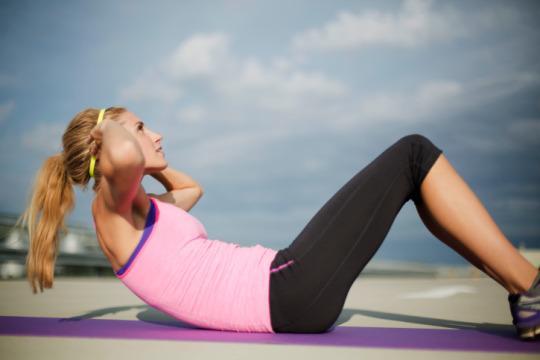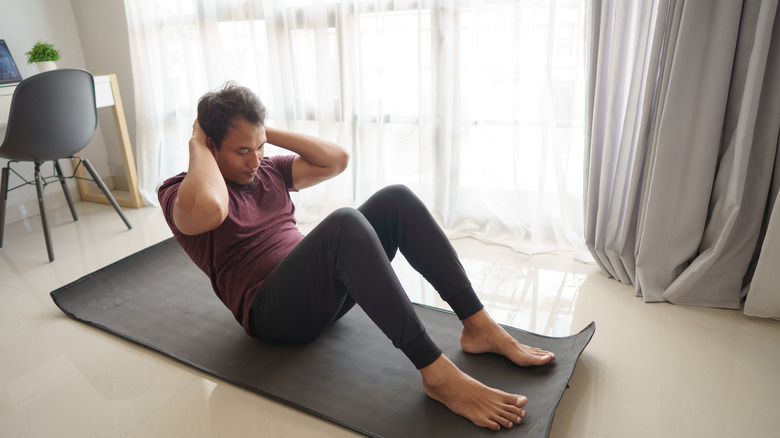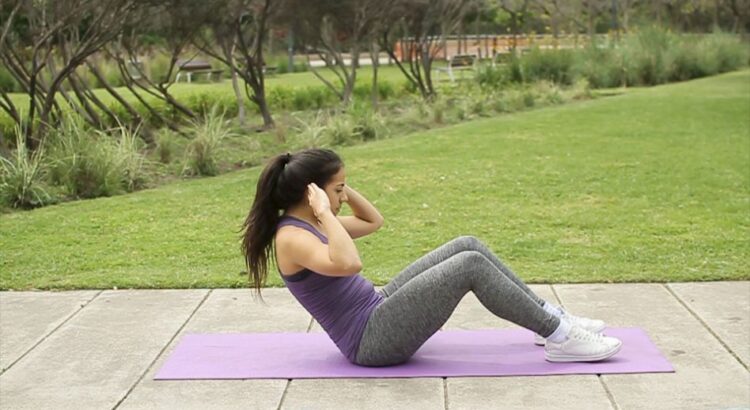The sit-up is a well-known test of core fitness, regardless of whether you are a regular gym goer, a strength athlete, or trying to pass a fitness test. It’s also not as simple as you might think, but if you can’t do them, there’s something we can tell you to make it simpler.
You’ll lie on your back, bend your knees, and place your feet flat on the floor to perform a sit-up. Please read this article carefully if you want to learn how to perform sit-ups properly.
What Is A Full Sit-Up?
For a full sit-up, you must begin with your torso flat on the floor and your feet and knees bent at a 90-degree angle. The next step is to lift your entire torso off the floor until your back is fully extended and as upright as you can make it.
You can cross your arms with your hands flat on your shoulders or hold your hands or fingers by the side of your temples. When performing a full sit-up, you must not pull or grab at the back of your head because doing so could injure your neck. Additionally, when performing either, you must not pull on your shoulders or top.
An abdominal crunch, which is a related exercise that begins in a similar position to a full sit-up, should not be confused with it. The range of motion and emphasis on how the exercise is performed are what distinguish a full sit-up from a crunch.
Without necessarily lifting your lower back off the floor, a crunch requires curling your back and ribcage off the floor. The entire torso must rise off the floor for a full sit-up, however. You can maintain a relatively flat posture while doing a full sit-up, so you don’t necessarily need to curl your back.
In order to increase core strength, endurance, muscle mass, and fat loss, a full sit-up can be performed as an exercise. As a test of endurance and core strength, it can also be a fitness evaluation.
For testing, it can be done as an AMRAP in which you complete as many reps as you can before failing or it can be done within a set time limit in which you complete as many as you can in that time. The sit-up test is a general fitness assessment tool that can be used in gyms and military settings alike.
Read More: How Many Calories Do Sit-Ups Burn?
Reasons Why You Can’t Do A Sit-up & Fixes
Your Core Is Weak
It makes perfect sense that sitting up would be difficult for you if you simply have a weak core. If you have ever suffered from a severe illness, injury, or other medical condition, this is even more likely. If there is no prior history of training or leading an active lifestyle, it is also reasonable for the majority of people.
The sit-up is definitely not the simplest form of core exercise, so it’s probably not the best place for everyone to start. It’s important to start where you are and take the action that is most appropriate for your level of fitness and experience.
The secret is to work on progressions if your weak core is causing you difficulty performing sit-ups. Starting with the exercises you can correctly complete right now to train your core, these movements get progressively harder.
After all, the best course of action is to back off and train until you can perform sit-ups if you’re too weak to do so. If you keep trying sit-ups and don’t see any improvement, there’s no point in continuing.
Your Hip Flexors Are Weak

The hips play a role in the sit-up, and if they’re weak, you’ll have some trouble performing it.
This is a problem for sit-ups as a whole, but it also shows a fundamental weakness you need to address. You have a fantastic chance to increase your overall strength and control once you’ve identified a weakness.
If you don’t give your hip flexors the care they need, they could become tight, frail, and even injured. There is a risk of overstretching them or allowing them to remain tight and/or short if you are having difficulty with them during sit-ups.
There are two ways to get around these restrictions: either by strengthening the hip flexors or by changing the movement.
Activating and bolstering the hip flexors is the best course of action. Movements like deep lunges, kneeling lunges, and the couch stretch all contribute to better hip flexor mobility and health. They include some of the most crucial hip and quad stretches for longevity.
You should also include exercises to strengthen your hip flexors on top of that. The psoas march and the kneeling hip flexion exercise are two that we’d rank as being particularly crucial.
You Have A Poor Posture For A Sit-up
You might be putting your muscles in the wrong position to work if you begin the exercise with poor posture. Your abdominals must be stretched out and weakened in order to work if your lower back is over-arched to the point where there is room between the floor and your lower back when you are lying down.
There are several cues to help you realize that your lower back should be flat on the floor in order to correct this.
You can achieve this by performing a posterior pelvic tilt, which involves tucking your pelvis under. You can accomplish this by contracting your glutes and pressing your heels firmly into the ground.
Another way to achieve this is to raise your arms towards the sky while fully exhaling until your abs and obliques contract. Your ribcage will become flattered and your back will be closer to the ground as a result.
You Have Poor Muscular Control
Although weakness and poor control are inextricably linked, they present differently and have different risks and training approaches.
Mobility, tightness, and inactivity rather than weakness specifically are the main causes of poor hip control. The goal is to increase the joint’s health and longevity, just as it is with the need for strength, especially given that the hip is almost always loaded and has a sizable range of motion in three dimensions.
Although the hip has similar extensive mobility to the shoulder, it is almost never loaded. Hip dysfunction puts the health, mobility, and ability to perform everyday tasks like walking in grave danger.
The hips and core need to develop control, which is essential. To maintain the spine’s health, these two parts must move freely both together and separately. This requires controlled hip and core movement in all planes of motion.
Planks and side planks, “curling up” movements, as well as lateral and rotational exercises, are all necessary for strengthening the core. For each of these, a slow and controlled movement could be enough: side bends, heel touches, wood chops, rotating lunges, etc.
This degree of control is also necessary for the hips. Cat-cows, dead bugs, bird-dogs, and other exercises offer a chance to build better core-hip coordination. Additionally, you ought to practice slow, controlled leg raises to a raised surface or object and gradually lower the end point!
You May Be Too Overweight
If you are too heavy, your core muscles might not be able to lift you off the ground when you do a sit-up because you are raising the weight of your torso.
The act of performing a sit-up may be very challenging if you are overweight and/or unaccustomed to exercise. Changing this so that you can do a sit-up might require a long-term solution rather than a quick fix.
You will need to combine exercise and nutrition so that you are in a caloric deficit, meaning that you are consuming fewer calories than your body requires to lose weight.

Cardiovascular and resistance training should be done during exercise. Both resistance training and cardiovascular exercise will help you burn calories and lose weight.
If you are new to exercise, you should begin with a full-body approach that includes twice-weekly resistance training and 75 to 150 minutes of aerobic activity.
You May Have Poor Technique
As with any exercise, proper technique is crucial. It’s possible to put yourself in an awkward and disadvantageous position when performing a full sit-up if you have poor technique.
The bad technique may have elements of:
- Pulling your head up
- Grabbing your shoulders forward
- Starting with an over-extended back
- Using momentum with your legs
- Sitting up by raising one side (right or left) higher than the other
Good technique will include the following qualities during a full sit-up:
- Starting with your back flat on the floor
- Keeping your feet firmly on the ground
- Keeping mild contact of your heads to your head or shoulders
- Reaching as high as possible
- Sit up relatively symmetrically
You May Be Currently Or Previously Injured
Your hip and back muscles and joints may be under stress from a full sit-up. You must make sure that any previous injuries in those areas are treated first if you have any.
Any injury will take time to heal, depending on its type, or you may need to do some rehabilitation exercises. Before starting any exercise or fitness program, it’s important to discuss any pain or pathology with a qualified medical professional or physical therapist.
You Lose Balance When Trying To Fully Sit Up
Ideally, while performing a sit-up, your legs should aid in your balance against your upper body. Sometimes you might be trying to sit up too quickly and lose your balance, or your torso might be heavier than your legs.
One of two things can be tried if you are attempting to sit up too quickly and your legs rise. Controlling the sit-ups’ speed of execution comes first. In order to distance your feet from you, try doing the second thing.
An easy fix is to perform an anchored sit-up, where your feet are supported externally to keep them on the floor if you find that your legs are lifting and you keep slipping back down when you sit up. To keep your feet planted, you can use a weight or another object.
Exercises To Help You Do A Sit-up
You may require core strengthening if you are unable to perform a sit-up. According to Livestrong, back pain can result from having a weak core. If your feet rise off the floor when you try to do a sit-up, you might just need to adjust your form; nobody wants that.
Simply step back a bit and try it again. Now you ought to be able to perform a sit-up.
It gets better with practice. Begin by practicing as many sit-ups as you can. According to Live Healthy, performing sit-ups regularly can help you get there. 20 times, raise your upper body as high as you can off the floor.
The plank is another exercise that will strengthen your core. With your feet flexed and your hands on the floor, perform a pushup. Hold for as long as you can with one to five repetitions, working up to 30 seconds at a time.
Exercise your legs by standing with your hands on your hips, lifting one leg out to the side as high as you can or to a 90-degree angle, and then lowering it slowly.
Do the same with the other leg. Knee raises are the next exercise. Raise one knee in front of you, then bring it back down. Repeat with the other knee. Do eight to sixteen repetitions once to three times.
